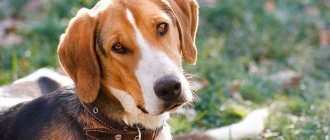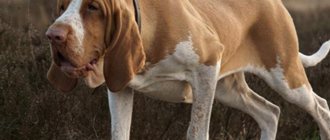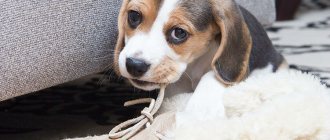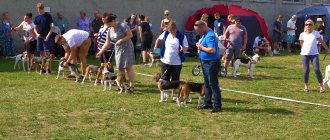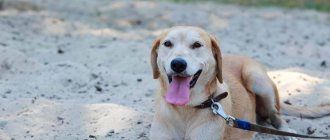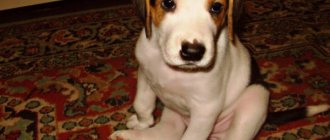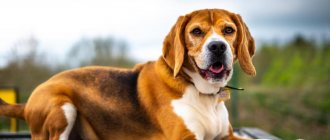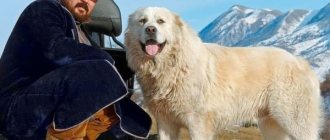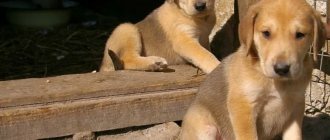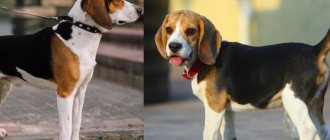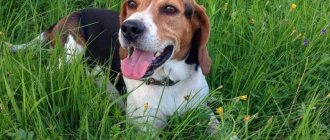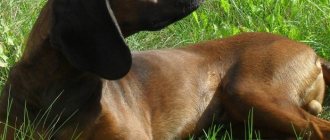Austrian Brandlbracke, Austrian Smoothhaired Hound, Austrian Hound, Carinthian Brandlbracke, Brandlbracke, Austrian Hound, Brandlbracke, Austrian Smoothhaired Hound)
The Austrian Hound is not a very common breed today and is found quite rarely, most often only in Austria itself. The Brundle Brakk is generally a very capable hunter who will not stop pursuing the prey until he finally drives it into a trap.
The hunting habits of this hound are manifested not only during hunting, but also in everyday life. The Brundle Brakk is a very stubborn breed and will get its way no matter what.
History of the breed
The history of the Austrian hound remains a mystery.
Almost all sources claim that the ancestors of the breed were Celtic dogs, called in German (language and Austria) “Kelten Brake”. Although most of Austria was inhabited by Germanic tribes since the fall of the Roman Empire, Celtic tribes, the same as those in Switzerland, France, and Belgium, also lived in it.
In addition, according to the descriptions, they are very different from each other. Even if this relationship existed, over hundreds of years the Austrian hound mixed with other breeds and became very different from its ancestor.
But, no matter where they came from, these dogs are very popular in Austria, especially in the mountainous regions. For many years they were not purebred, but mixed with other breeds, but in 1884 the Australian hound was recognized as a separate breed, and a standard was written.
In its homeland, it is widely known as “Brandlbracke”, which can be translated as a fire hound, based on its coat color. Smooth-haired Brackets were used in hunting rabbits and foxes, tracking down larger animals, usually in small packs.
At one time, Austrian Brackets were kept only by the nobility, as was the case with many dogs in Europe. Only the nobility had hunting rights on their territory; it was a popular pastime and hunting dogs were highly valued.
Unlike many modern dogs, the Austrian Hound is still used as a hunting dog today, and will remain so for the foreseeable future.
Brief historical background
There is no reliable historical data on the origin of the Austrian hound, so it is not possible to say exactly when it arose. The Celtic hound is considered to be the ancestor of the Brandl Brack, but this is only an assumption; no documentary evidence of this fact has been found so far.
Endemic dogs of a similar type lived for many years in the Austrian mountains, freely interbreeding with local aboriginal breeds. Until the middle of the 19th century, no one was breeding them. But already in 1884 the first breed standard was described, and from that time on the mixing of different types of dogs stopped. Since then, the Austrian Bracket has been bred in purity.
The international canine community recognized the breed in 1954. It is entered in the FCI register under number 63 (group 6 - hounds, bloodhounds and related breeds, section 1.2 - medium-sized hounds). The current and most current version of the standard dates back to June 18, 1996.
The Austrian Hound is very little known outside of its homeland.
The Austrian Hound is widely known only in its historical homeland. Outside of Austria it is practically never found.
Character
Born to work in a pack, Austrian hounds are very calm towards other dogs and even prefer their company. But, as a hunting dog, they are very aggressive towards other small animals, and can chase and kill them.
I recommend: Alopekis: photo, description of the breed
Smooth-haired Brackets do not tolerate life in the city very well; they need a spacious yard, freedom and hunting. Moreover, during the hunt they give a vocal signal about the discovered prey, and as a result are more vocal than other dogs.
Origin
The origin story is quite confusing. According to one version, the ancestor of the breed is the Tyrolean hound. According to the second, the hound from Austria descended from Celtic dogs. These are the closest related breeds. This hypothesis is hardly plausible. The difference between the Celtic Braque and our hound is a thousand years. If, however, Celtic dogs took part in the formation of the Austrian hound, then it is quite distant. The Austrian Hound is completely different from its supposed ancestors. Differences in appearance can be explained by admixtures of new blood. The hound from Austria was shaped not only by Celtic dogs. The genetics of other breeds have taken their toll. Nobody knows if this is true. It is known that the Brandl Brack, as the breed is also called, has become widespread in Austria. And in 1884 a breed standard was created.
The photo shows an Austrian hound.
Socialization
Noisy but not aggressive dog. The Austrian Bracket gets along well with his own kind. The dog hunts in a pack, so he is absolutely accustomed to his relatives.
The pet is friendly with strangers, but acts aloof. If you pet him, he will endure it; he will not impose himself with affection.
Like any self-respecting hunter, he considers living together with other animals beneath his dignity. The cats will be instantly strangled. There will be no wet place left from rodents.
Dog's habitat
Despite the fact that the dog is of medium size, it is better not to buy it for living in an apartment. Austrian Pinschers are very active, they constantly need space to run around and be pampered. By nature, they are very freedom-loving and without space they quickly begin to lose their positive qualities and performance characteristics. In cramped spaces, they become passive, sad, and in some cases even aggressive. To live a full life in a city apartment, they need to walk and run in the fresh air for at least 5 hours a day. Not everyone can provide such a luxurious walk.
That is why the best place to live for a dog of this breed is considered a country house. Only there will the dog maintain its physical shape and fully demonstrate its instincts. From the photo of the Austrian Pinscher we can safely conclude that it is in the open area that the animal feels happiest. The house must have a wide area so that the dog can walk and run freely without a leash. Only in such conditions will the Austrian develop well and show his best natural characteristics. It is advisable to make an insulated enclosure on the site so that the dog can rest in it without being on a chain. The Austrian Pinscher is an excellent guard, watchman and just a friend who will protect his owner and his home around the clock.
Features of maintenance and care
The Austrian Smooth-haired Bracket is easy to care for. He is able to be content with little. This does not mean that you can give up on the dog. There are some requirements for its content.
Combing
The pet is brushed several times a week. Dead hairs are removed so that the dog does not scatter them around the enclosure.
During shedding, the Austrian Hound needs daily grooming.
Bathing
The animal practically does not need it. Wool has self-cleaning properties. Twice a year is enough for water procedures. If your pet gets very dirty, you will have to wash it.
Walk
Running after a ball or puller will be the best entertainment during a walk.
Balanced diet
The basic rule of a healthy diet for brakka is the predominance of meat. Do not forget that any mammal needs vitamins and microelements for health, especially during the growth stage, while your pet is still a puppy. The easiest and most reliable way to provide such nutrition is high-quality ready-made food. Do not neglect the manufacturer's recommendations for the daily dose to prevent your pet from overeating. Do not mix packaged food with regular “human” food: having decided to feed your pet with ready-made food, do not treat it to a piece of meat, no matter how difficult it may be sometimes. Treating a bad stomach and other consequences of poor nutrition will be much more difficult. Purchasing an Austrian Braque should be the result of thoughtful decisions and good preliminary preparation. You need to choose a nursery carefully: what is its reputation? In what conditions are puppies born and raised? Experienced and responsible breeders will easily provide you with detailed information about the nursery and its inhabitants.
Xoloitzcuintle - description of the breed and character of the dog
Description of the Austrian Hound
Brandle Brackets are kept extremely rarely as pets and companion dogs.
Appearance
The body of the Austrian Hound is muscular and strong, but rather graceful and fine-boned.
The Austrian Black and Tan Hound moves easily and gracefully. Thanks to its lightweight frame, it has excellent jumping ability.
The Austrian Hound moves easily and lithely
Disadvantages and disqualifying vices
The following are recognized as defects or deficiencies:
The reasons for disqualification will be:
Character and psyche of the breed
The Austrian Hound needs to exercise a lot.
Only a real hunter or a professional huntsman should have such a pet.
The poorly developed territorial instinct does not allow the use of hounds as guards. Although they perceive uninvited strangers with suspicion, they do not possess the necessary aggressiveness.
Appearance
The Austrian Hound is a medium-sized dog with a flexible body and short coat of black and tan color. Weight is not fixed by standard; it usually ranges from 16-27 kg. Height at withers:
- Males - 50-60 cm;
- Females - 48-54 cm.
The head is proportional to the size of the body. The skull is wide. Muzzle with a straight back of the nose, strong, not very pointed. The lobe is black. The lips are well developed, fit tightly, and are well pigmented. The jaws are strong. Complete set of teeth. Scissor bite. The eyes are dark brown. The ears are set high, hanging, flat, of medium length, not very wide.
Due to its physique, the Austrian Hound is very maneuverable and jumping.
The neck is strong and of medium length. The body is strong and very flexible. The withers are well expressed. The back is long. The loin is slightly convex. The croup is slightly sloping. The chest is deep and wide. The tail is set slightly below the level of the back. When at rest, it is lowered, long, tapering towards the tip. The hair on the underside of the tail is coarser. The limbs are very well developed with moderate bones and strong joints, straight and strong. Hind limbs with well-defined angles. Paws are arched, rounded, strong. The fingers are well collected. The pads are elastic and large. The claws are black and strong. The gait is flexible and light.
The coat is close-lying, short, dense, strong, dense, with a glossy sheen. Hair length is approximately 2 cm. The color is black with small clearly defined tan marks (from fawn to dark red). There must be a tan above the eyes.
Caring for the Austrian Hound
Hounds feel best when free-ranging.
Caring for Austrian Braques is simple, it consists of the following activities:
Real hunters prefer to feed their pets homemade, specially prepared food. The natural diet includes:
It is forbidden to give hounds human food from the common table, as well as fatty, sweet, very salty, peppered, smoked foods.
Training
It is imperative to raise and train the Austrian Hound.
It is better to entrust further training and training to a professional hunter or dog handler.
Key points in training
These dogs are hunters by genetics and temperament. They are serious, stubborn and independent. To raise a good pet you need to have a strong character. A beginner cannot cope with such a dog.
Such a dog needs to be trained from 3-4 months, but raised from birth. The pet must know that the person in the house is in charge and must be obeyed. To do this, you should not allow the puppy to jump on the owner’s furniture, beg, manipulate, or whine for no reason. The owner always needs to remain a leader and show this to the dog. But you cannot resort to harsh methods: hitting your pet, insulting, humiliating. To show the hound that she is wrong, you can pull the collar, deprive her of treats or food.
Basic commands are learned by the puppy after he has memorized his name. By 4 months, the dog should respond to its name, know the walking and feeding schedule, and respond to basic commands: “No”, “Place”. Then you can train reflex reactions to other words: “Sit”, “Voice”, “Quiet”.
Character of the breed
The Austrian Smooth-haired Bracket is a rather angry and aggressive dog. He is always ready to fight back, and in case of provocation he is able to attack first.
Relationships with relatives of the same sex are especially difficult, so you should not keep them together.
The brakk shows respect for the owner's family and tries to protect it in every possible way. Does not like strangers and strangers in the house. In general, the attitude towards people is friendly, but wary. Very loyal to his owner.
The dog is recommended for keeping by gamekeepers and hunters. Not suitable as a regular pet.
Choosing a puppy
What should a “gonchak” be like? Active and curious. It is better to take any dog from a kennel. With the exception of hunting ones. They are purchased from professional hunters, and such a puppy costs an order of magnitude cheaper. But its working qualities are much better than those of its “greenhouse brother”.
The Austrian hound is little known in Russia. There are no nurseries engaged in breeding the breed. Therefore, you can only buy a puppy in Austria.
For those who have decided to take such a brave step, it is important to know: they do not like to sell dogs abroad. Especially good ones to Russia. Asking a breeder for help in choosing a puppy is pointless. The main factors that the buyer relies on are the baby’s attitude to the world around him. How he behaves with his brothers and sisters, how he reacts to strangers, whether he is interested in a new toy just offered. If the puppy is active, is a leader among his littermates, and actively attacks the toy, he will grow up to be a good hunting dog.
Health
This breed of dog gets sick very rarely . If you look after her carefully and diligently, she will not get sick. Her good health and good immunity do not allow various infections to affect her body. Like most dogs, she can develop illnesses, but these are exceptions. She, like all hounds, suffers from hip and elbow dysplasia in general, like most dogs. Her floppy ears may be causing an infection.
It is necessary to carefully and diligently monitor them, especially after each hunt, you need to inspect the auricle. It is extremely rare that she can become infected with demodicosis.
